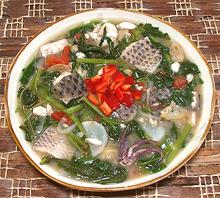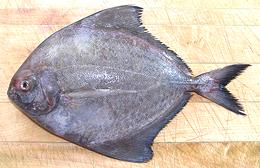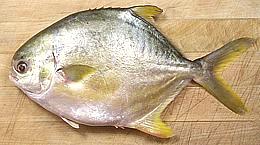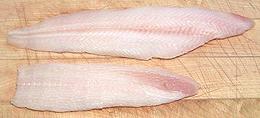
When we say "Best Fish" we mean selections that stay intact or at least fairly intact with the wet cooking times needed for these dishes. There are fish soups that are puréed or it is desirable for it to fall apart into flakes. The fish here will all work fine for purée, but avoid the "Very Firm Fish" if you want them to flake apart in the soup. The photo is of a Philippine Fish Sinigang.
We have included mainly fish that can frequently be found here in Southern California. If you have an unusual fish, check our main Varieties of Fish page (very large page).
More on Fish.
 [Lethrinus species]
[Lethrinus species]
These Indo - West Pacific fish are fairly common in Asian fish markets,
but often mislabeled. They are usually around 1-1/2 pounds. They can
often be used as a substitute for Monkfish.
Details and Cooking.
Character: Light-medium distinctive flavor, low oil,
very firm for long cooking.
Stock: Not preferred.
 [Angler, Lophius americanus (North America),
Lophius piscatorius (Europe)]
[Angler, Lophius americanus (North America),
Lophius piscatorius (Europe)]
This fish is often called for in soup and stew recipes, but is fairly
expensive. Monkfish is mostly a huge ugly inedible bony head and only
the small tail end is sold, usually about 1-1/4 pounds.
Details and Cooking
Character: Light Lobster-like flavor, low oil, very
firm for long cooking. Not kosher.
Stock: Mild and pleasant - but not much of it so may
be blended with other stock.
 [Snakehead murrel; Dalag (Phil.); Murrel (India); Channa striata]
[Snakehead murrel; Dalag (Phil.); Murrel (India); Channa striata]
This is one of the most important food fish in Thailand, Vietnam and
Malaysia, and popular in India and the Philippines. It can grow to
6.6 pounds but is commonly marketed at 1-1/2 pounds.
Details and Cooking.
Character: Light-medium flavor, low oil, firm enough
for long cooking.
Stock: Use skins only. In Asia skins are sold
separately at a higher price.
 [Genus Scarus]
[Genus Scarus]
There are a number of Parrot fish found in the Asian fish markets, and
they are difficult to identify with certainty, but don't dispair, they
all cook pretty much the same.
Details and Cooking
Character: moderate flavor, low oil, firm enough for
soups, stews and curries.
Stock: A little too strong, and usually greenish.
 [Parastromateus niger]
[Parastromateus niger]
Actually a Pompano, not a Pomfret, this is a prized eating fish. It can
be cooked by just about any method, and used skin-on or skin-off.
Details and Cooking
Character: pleasant mild flavor, but not bland. Firm
enough for soups, stews and curries.
Stock: excellent for soup, mild and almost clear.
 [Trachinotus carolinus (Florida Pompano, Common Pompano);
Trachinotus blochii (Golden Pompano, Asian Pompano)]
[Trachinotus carolinus (Florida Pompano, Common Pompano);
Trachinotus blochii (Golden Pompano, Asian Pompano)]
This is an outstanding fish for almost any method of cooking, skin-on
or skin-off. It is heavily farmed so almost always available.
Details and Cooking
Character: pleasant mild flavor, but not bland. Firm
enough for soups, stews and curries.
Stock: excellent for soup, mild and almost clear.
 [Nile Tilapia; Oreochromis niloticus niloticus]
[Nile Tilapia; Oreochromis niloticus niloticus]
This is a good general purpose fish, and I always keep some frozen
fillets handy. Whole fish are 1 to 2 pounds, fillets 5 to 10 ounces.
This fish has been farmed for at least 4000 years.
Details and Cooking.
Character: mild but not insipid taste, can stand
moderate wet cooking.
Stock: Good moderate stock, even with skins included.
 [Slime Fish, Slippery Sole; Microstomus pacificus]
[Slime Fish, Slippery Sole; Microstomus pacificus]
This fish is NOT the Dover Sole called for in European recipes
(that one is Common Sole, Solea solea). Fortunately, you are
unlikely to encounter this one except as frozen fillets - and that's bad
enough.
Details and Cooking.
Character: insipid taste, tremendous shrinkage in
cooking, and will fall apart if you look at it hard.
Stock: don't even think about it.